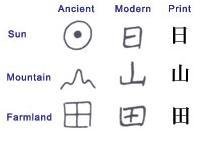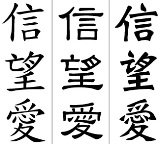
There are numerous Chinese languages spoken in China, the two most commonly known and used are:
- Mandarin (Standard Official Chinese) (普通話)
- Cantonese (廣東話)
Standard Official Chinese (or Mandarin in English) is known as "Putonghua 普通話" (Common Language) in People's Republic of China, or as "Guoyu 國語" (National Language) of the Republic of China (Taiwan) and is by far the most widely used.

The PRC government has calculated (in 2007) that 1.136 billion persons (or 86% of its population) are speakers of Chinese, and that 700 million of them (or 53% of the total population) can communicate in Standard Mandarin.
Cantonese is spoken in the South of China (Guangzhou [Canton]), Hong Kong and Macau, it can also be found prevalently spoken in overseas Chinese communities.
Written Chinese
Chinese has two written variations:
- Traditional Chinese (繁體中文)
- Simplified Chinese (简体中文)
Simplified Chinese was introduced to boast literacy levels in Communist China (1952), though the simplification of the writing system had been considered since 1905, the idea behind it was to reduce the number of strokes needed to write a character, making it easier to learn. This simplified system is taught throughout mainland China. Taiwan, Hong Kong, Macau and Singapore have continued to use the traditional writing system as do overseas Chinese communities (although simplified Chinese is finding its way into these communities with increased migrants from China).
Below are samples of Simplified and Traditional Chinese, both sentences say: "All human beings are born free and equal in dignity and rights. They are endowed with reason and conscience and should act towards one another in a spirit of brotherhood." Each uses the same Chinese and are grammatically identical, it is just the complexity of the written character that differs:
Simplified Chinese:
人人生而自由,在尊严和权利上一律平等。他们赋
有理性和良心,并应以兄弟关系的精神互相对待。
Traditional Chinese
人人生而自由﹐在尊嚴和權利上一律平等。他們賦有
理性和良心﹐並應以兄弟關係的精神互相對待。
It remains an academic question as to how many characters are needed to define a person as literate, estimates range between 2,000-3,500 Chinese characters for basic literacy (ie: to read a Chinese newspaper), and a well-educated person will know well in excess of 4,000 to 5,000 characters.
Chinese Characters
Chinese characters are called ideographs which have no relation to the sound of a word, but originally they were a picture or pictograph, such as a crescent for the moon as depicted below:
The moon:

Or sun

Other characters can also be traced back to their ancient foundations:

Gradually these gave way to non-pictorial ideographs that no longer bear resemblance to their original conception (as demonstrated above).
Each character has its own meaning (like a word), Modern Chinese has to use a combination of characters to represent the modern world and it concepts.
For example Computer is written:
[simp.,] 电脑 [trad.,] 電腦 meaning 'Electric Brain'.
Each character is equivalent to one word, although as you can see below, various characters are required to describe a word:
Microprocessor [written (simpl.,) : 微处理器] [literal translation is: Tiny management machine]
Telephone: 电话 (電話) becomes 'Electric Speech'.
Difficulties can sometimes arise when reading Chinese, as you have to work out what the characters mean and how to pronounce them, but also which characters belong together to create the corresponding English word.
The majority of Chinese characters, however, consist of two elements: a "signific", which indicates the meaning of a word, and a "phonetic", which indicates the sound.
Chinese verbs and adjectives consist of one character but nouns consist of two or more characters.
There are no spaces between characters and the characters occupy a more or less square area.
Since the Chinese characters are also used in Japanese, each language, when written, is partially intelligible to a speaker of the other, despite the fact that the two spoken languages are totally dissimilar.
Direction of writing
 Up
until 1956 Chinese was written from right to left in vertical columns.
Up
until 1956 Chinese was written from right to left in vertical columns.
Since 1956 it has become more westernised, being written from left to right and horizontally. Although some signs maybe written vertically. The horizontal writing of Chinese is normal in Singapore, and it has been gradually adopted in Hong Kong, Macao and in overseas Chinese communities since the 1990s.
Vertical text remains popular in Taiwan however, though horizontal text is used as well. In Taiwan newspapers and magazines with vertical text, some of the headlines and titles are written horizontally right to left across the top of the main text.
 If
you want to arrange horizontal characters vertically, the one on the left
should go on top:
If
you want to arrange horizontal characters vertically, the one on the left
should go on top:
Improvements to this site?
Chinese Translation sample (Simplified):
人 人 生 而 自 由, 在 尊 严 和 权 利 上 一 律 平 等。 他 们 赋 有 理 性 和 良 心, 并 应 以 兄 弟 关 系 的 精 神 相 对 待。
All human beings are born free and equal in dignity and rights. They are endowed with reason and conscience and should act towards one another in a spirit of brotherhood. (Article 1 of the Universal Declaration of Human Rights)
Chinese Speaking countries
People's Republic of China (Hong Kong, Macau, Taiwan), Singapore, Malaysia (Chinese minority).
Difficulty in learning Chinese as a native English speaker
The Defense Language Institute categorizes Chinese as very difficult, the hardest (level 4, of 4 levels)
Business Chinese phrases
- Basics
- Time
- Telephone
- Food
Chinese Business Etiquette
- Meeting
Handshakes are popular but wait for your Chinese counterpart to initiate the gesture.
Most people should be addressed with a title followed by their last name. If a person does not have a professional title simply use "Mr.", "Madam", "Miss", plus the last name, never refer to someone as "comrade."
Negative answers are considered impolite. Answer "maybe", "I'll think about it", or "we'll see" instead of a blunt "no".
When your Chinese counterparts politely say "Not a big issue" or "The problem is not serious", they usually mean "There are still problems".
Terms such as "Red China", "Mainland China", and "Communist China" are to be avoided. Just "China" will suffice.
Official policy in Chinese business culture forbids gifts. The gesture is considered bribery, an illegal act in the country.
- Peculiar quirks
"Eight" is deemed as one of the luckiest numbers in Chinese culture. If you receive eight of something, consider it a gesture of good will.
"Six" is considered a blessing for smoothness and progress. "Four" is taboo because it means "death".
Other numbers such as "73" meaning "the funeral" and "84" meaning "having accidents" should be avoided.
Giving tips is generally considered an insult in China.
- Eating
During a meal, 20 to 30 courses can be served, so try not to eat too much at once. The trick is to tuck in a sample of each dish.
Scorpions, locusts, snake skin, dog meat and blood are considered premium delicacies.
Leaving an empty dish is perceived as if you were not given enough food: a terrible insult to the Chinese.
Leaving food untouched will also purport offence. Even if you find a dish unappealing, try a small portion just for the sake of politeness.
Building a personal relationship ("guanxi") during your business is very important. Part of this involves participating in the strong drinking culture that exists in the country.
Sometimes, the Chinese enjoy testing the ability of a foreigner ("lao wai") to handle alcohol, especially "er gua toe", a powerful booze that might be compared to airline fuel. A good practice would be to eat something beforehand.
- Negotiation
Being late for an appointment is a serious offence in the Chinese business culture.
The best time for scheduling an appointment is April to June and September to October.
Many Chinese workers take a break between 12:00 and 2:00 pm. Almost everything 'shuts down' during this period, from lifts to phone services.
Speak in short, simple, jargon-free sentences. Pause frequently.
Printed presentation materials should be only in black and white. Colours are to be avoided.
"Saving face" is an important concept to bear in mind. Causing embarrassment or loss of composure can be disastrous for business negotiations.
People are expected to enter the meeting room in hierarchical order. Chinese will assume that the first foreigner to enter the room will be the head of the delegation.
Be patient, accept that delays will occur and do not mention deadlines.
When the meeting is finished, you are expected to leave before your Chinese counterparts.
You may have to go back several times to achieve your objectives. Chinese businesspeople prefer to establish a strong relationship before closing a deal.